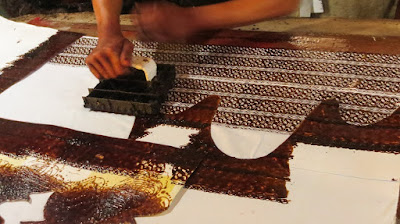 |
| Our kapok padding, while still hanging on the tree. |
Hello everyone,
Since we believe it is important to know what you buy we like to give you some more information about our book clutches, how they came into existence and how they are made.
Nowadays people travel a lot, and even if they stay in their country, they are still always travelling.
Now, we like to read so we always have a book or two with us. You never know we can read some on the metro, on the bus, waiting for the metro or the bus.
These books suffer! We have so many times given ourselves a hard time for the state of our book after a day or two in our handbag or backpack. For sure you know the feeling.
So that is how we started making and using our first book clutch
- and we saw it was good. And other people saw it was good so they started asking for one.
Second step, if you are going to be making clutches to help people protect their books, not just one for yourself, which fabrics will you make them in. There was no way we were going to use synthetics (poor books, imagine being wrapped around in that all day) and, since we have a fascination for textile crafts, there we went, we could use handmade and traditional fabrics (art) to design our book clutches.
So far so good.
Then clients started asking for a clutch for their kindle, their tablet, etc. So we went to the drawing board again and think, what should we use for padding. There was no way we were going to use the easily available (foam, spunge or industrial felt) options. We found our holy grail in Kapok. Our Kapok padding is made from the fibres that are the fruit of a tree, the Kapok tree. These trees grow abundantly in tropical regions and there is no extra water, care or chemicals needed for these trees to grow.
 |
| Kapok fibre |
 |
| Kapok tree |
That is how we ended up hand-making our own Kapok padding for our book clutches.
There was one more thing to decide, the buttons. Initially we just went with what we could find but then 2 friends pointed us towards using coconut shell for buttons. We were so happy when we found the artisan who still hand-turns these buttons so from that moment onward all our buttons are made of coconut shell. Again, this is a side product from the coconut tree. There is no extra water, care or chemicals needed to produce coconut shells. So we saw it was good.
And our book clutches were ready.
 |
Green Lucky Clouds, block print batik, padded
|
That is the story behind our book clutches. A truely useful and purpose-ful product, hand made with love and care for all involved. On our website you can see our variety of book clutches, with and without padding. We sew every piece here in our atelier in Istanbul and we source the fabrics at origin on our travels, because we believe we can move into the future by preserving what is best about our past. As you take care of your books, you help us take care of the preservation of the ancient textile crafts.
Thank you for reading this post. Take care and we are looking forward to see you in our next blog post.
Marijke Jordens












